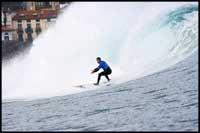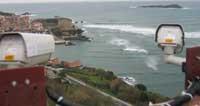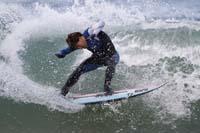Surfing in the Mundaka wave
2009/08/16 Kortabitarte Egiguren, Irati - Elhuyar Zientzia

Surfing arose on the Hawaii islands and, after opening up to the United States, reached us. Nowadays, surfing in Euskal Herria is quite widespread, since we have a large coast like Zarautz, Mundaka, Zurriola... Mundaka beach, for example, is a surfing paradise for many surfers around the world. The left wave there attracts outsiders and there is an annual round of world championships of great impact.
Left wave

What is special about the left wave of Mundaka? It is a special wave and is one of the ten best waves in the world, according to surfers. It is a long wave. This means that surfers can do many maneuvers. On the other hand, the bottom of Mundaka, even if it is sand, is quite fixed, so it forms a very clean and beautiful wave, which is a very tubular wave.
A few years ago it was written and talked about the disappearance of the wave. The initial disappearance was attributed to the ecosystem and climate change, but several investigations showed that the problem was due to the alteration of the remains of the Mundaka estuary. This modification consisted in the construction of the dredging to recover the dunes of Laida beach and facilitate the departure of the Murueta shipyard.

There is precisely the key to the left wave of Mundaka: the sand bar and the sedimentation of the estuary form a triangle that forms when the sea currents hit with the end of the triangle. The transformation of the bar and the discharge of the estuary as a result of changes in the remains of the bottom weakened the wave.
Quality control
In any case, as the phrase says, nature takes back what is theirs, and this time it has also been. With the passage of time, the sand bar and the estuary have recovered their original characteristics and the weakened surf has recovered again in recent years. You can also consult surfers or researchers at the Azti-Tecnalia technology center. In fact, they have conducted an investigation into the Mundaka wave. They have analyzed the direction, height and period of the waves, as well as the direction and strength of the wind, with the aim of knowing the conditions and characteristics of a wave so appreciated for surfers from all over the world. For this purpose they have used data of 17 years, between 1991 and 2008. Somehow, after analyzing the quality of the wave in real time, they have seen what day and what hours are suitable for surfing. The results of the studies indicate that in one of every three days of the year the wave of Mundaka is perfect for surfing. In addition, an average dedication of more than three hours per day is allowed.
In addition, they have concluded that in the winter months you can practice more surfing in Mundaka, more than half the days. Between every month, in January there are the best conditions for surfing in Mundaka, specifically 62% of the days. However, in the rest of the year there are also many days of surfing. For example, in the spring months, good surf sessions can be done in 25-50% of days. If you like surfing there are no excuses.
Published in 7k

Gai honi buruzko eduki gehiago
Elhuyarrek garatutako teknologia




